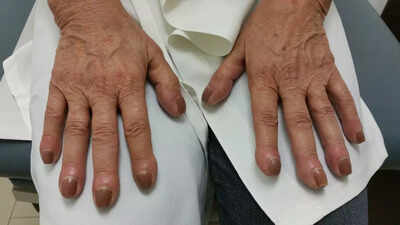Lung cancer symptoms on fingers: Finger clubbing, nail changes and other warning signs that could indicate serious health risks |

Lung cancer is one of the deadliest forms of cancer globally, largely because its early symptoms can be subtle and easily overlooked. Timely detection is often difficult, making awareness of even minor warning signs essential. One such indicator is finger clubbing, a noticeable change in the shape and curvature of the fingernails. This condition can sometimes reflect underlying lung disease, including lung cancer, although it does not always appear in the early stages. Understanding the characteristics of finger clubbing, why it develops, and recognizing when to consult a healthcare professional can provide valuable insights into your overall lung health. Early attention to these signs can improve the chances of diagnosis and effective treatment.
Understanding finger clubbing and its key signs for early detection
Finger clubbing, sometimes called digital clubbing, refers to the swelling of fingertips and a distinct change in the curvature of the nails. This condition often develops gradually, making it difficult to notice in its early stages. Typical features include:
- Bulging or enlarged fingertips
- Soft nail beds where nails feel less firmly attached
- Fingernails curving downward around the tips
- Nails that angle sharply from the cuticle
Early changes may appear as subtle softening or reddening of the nail bed, while more advanced clubbing leads to the characteristic downward curve and glossy, spoon-like shape of the nails. Enlarged fingertips are a common accompanying feature.
How finger clubbing relates to lung cancer
Finger clubbing is most commonly linked to lung cancer, appearing in roughly 80% of people with the condition who exhibit this symptom. However, it usually develops in later stages rather than at the very onset.The exact mechanism is not fully understood, but researchers believe it involves low oxygen levels and an overproduction of growth factors that stimulate blood vessel development. These processes can be triggered by lung cancer or other chronic lung conditions.Recognising early changes in your nails can help you seek timely medical advice and potentially detect lung cancer or other serious illnesses sooner.
Other lung cancer symptoms on fingers
- Cyanosis (Bluish Fingernails): A bluish tint to the fingernails can indicate low oxygen levels in the blood.
- Swelling or puffiness: Swollen fingers may be linked to fluid retention or circulatory issues, potentially associated with lung cancer.
- Changes in nail texture: Ridges, brittleness, or unusually fast nail growth can occur, sometimes reflecting underlying lung disease.
- Pain, numbness, or tingling: These sensations may indicate nerve involvement or paraneoplastic syndromes associated with lung cancer.
- Cold or pale fingers: Reduced blood flow caused by vascular complications from the cancer can lead to cold or pale fingers.
Other causes of finger clubbing
Although lung cancer is a leading cause, finger clubbing can result from various medical conditions, including:
- Chronic lung infections such as bronchiectasis or cystic fibrosis
- Liver diseases like cirrhosis
- Certain cancers, including liver cancer or Hodgkin lymphoma
- Viral infections such as HIV or hepatitis B and C
Additionally, some medications and cancer treatments can alter nail appearance, producing changes that may mimic finger clubbing. Discussing any nail changes with your healthcare provider is crucial, particularly if you are undergoing treatment.
Recognising finger clubbing at home
Because finger clubbing develops slowly, it can be hard to detect without a self-check. The Schamroth sign is a simple test:
- Place the nails of corresponding fingers together (usually index fingers) so the tips touch.
- Normally, a small diamond-shaped window appears between the nails.
- If this window is absent and your fingertips curve outward, it may indicate finger clubbing.
This home check is not a replacement for professional assessment, but it can help identify subtle changes early.
Can finger clubbing be reversed or treated
Finger clubbing itself does not require direct treatment. Instead, the focus is on managing the underlying condition causing it.
- If caused by a temporary or treatable condition, finger clubbing may improve.
- If linked to chronic illnesses like advanced lung cancer, clubbing may persist permanently.
Even long-term, identifying finger clubbing can provide your healthcare provider with valuable information about your overall health status.
When to see your healthcare provider
Any noticeable changes in nails or fingertips should prompt a consultation. Your doctor may:
- Examine the fingers and nails for abnormalities
- Ask about other symptoms, such as persistent cough, shortness of breath, or fatigue
- Order blood tests, imaging, or other investigations to determine the underlying cause
- Early medical evaluation is particularly important if finger clubbing is accompanied by other signs of lung cancer or systemic disease.
Also Read | Understanding kidney attacks: Hidden symptoms, common causes and ways to protect your kidneys






